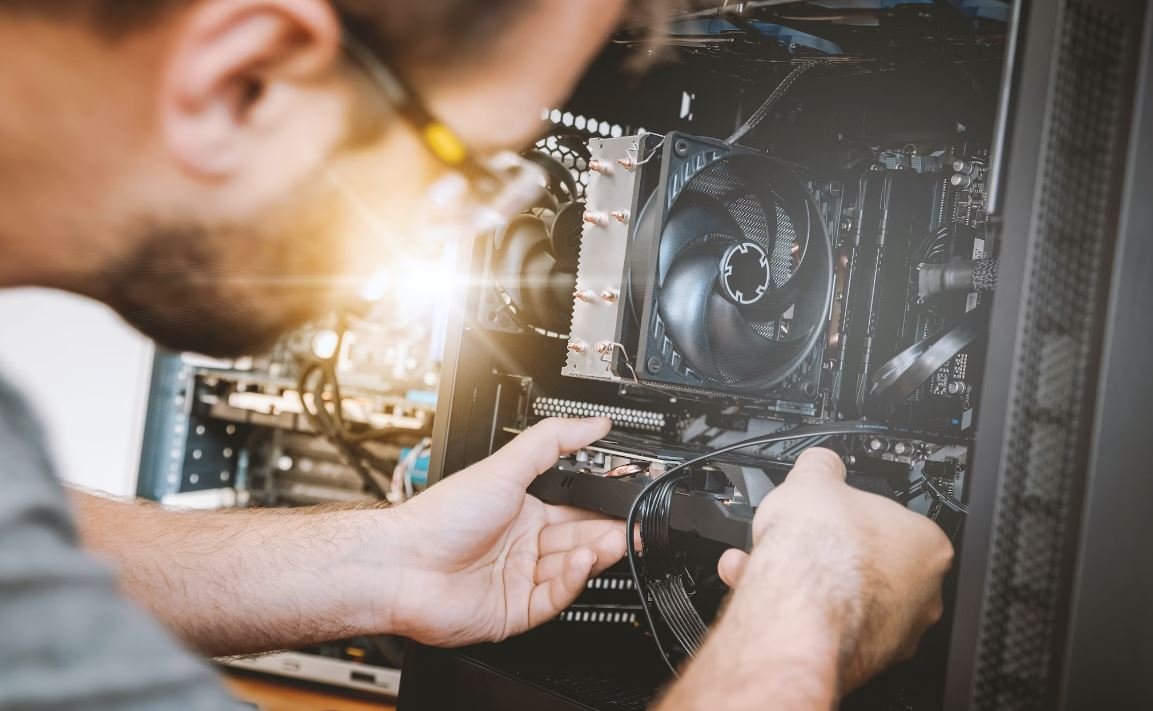Neural Networks from Scratch
Neural networks are a fundamental building block of artificial intelligence and machine learning. They are mathematical models designed to replicate the way the human brain processes information, enabling computers to learn from data.
Key Takeaways:
- Neural networks mimic the functioning of the human brain to solve complex problems.
- They are widely used in applications such as image recognition, natural language processing, and autonomous driving.
- Building neural networks from scratch allows for a better understanding of their inner workings.
- Neural network implementation involves defining the structure, selecting an activation function, and fine-tuning the parameters.
Neural networks are composed of artificial neurons, also known as perceptrons. These basic units receive input values, apply weights to them, and pass the weighted sum through an activation function to produce an output. *The activation function introduces non-linearity into the network, enabling it to model complex relationships between inputs and outputs.* By stacking multiple layers of interconnected neurons, neural networks can learn and extract intricate patterns from massive amounts of data.
When implementing a neural network from scratch, several crucial steps need to be followed. First, the structure of the network, including the number of layers and neurons per layer, must be defined. Second, an appropriate activation function, such as the popular ReLU (Rectified Linear Unit) or sigmoid function, is selected. Third, the network’s parameters, including weights and biases, need to be initialized. The network is then trained by iteratively adjusting the parameters using optimization algorithms, like gradient descent, to minimize the difference between predicted and actual outputs.
| Activation Function | Range | Advantages | Disadvantages |
|---|---|---|---|
| ReLU | [0, infinity) | – Avoids vanishing gradient problem – Faster convergence for large models |
– Not suitable for negative inputs – Can result in dead neurons (output=0) |
| Sigmoid | (0, 1) | – Maps any input to a probability – Smooth gradient for gradient descent algorithm |
– Prone to vanishing gradient problem – Slower convergence |
One interesting aspect of neural networks is the ability to learn from labeled data. Through a process called supervised learning, a neural network can be trained on a dataset where inputs and desired outputs are provided, allowing it to learn the underlying patterns and relationships. *This ability to generalize from examples is what enables neural networks to recognize objects in images or translate text into different languages.*
During the training process, the neural network continually adjusts its parameters to optimize its performance. The most common method used for this purpose is gradient descent, where the network evaluates the error between predicted and actual outputs and updates the parameters in the direction of the steepest descent to minimize this error. The learning rate, which determines the step size in each update, plays a crucial role in balancing convergence speed and accuracy.
The Impact of Neural Networks
Since their inception, neural networks have revolutionized various fields, with widespread applications in society. Here are some examples:
- **Image Recognition**: Neural networks are used to identify objects, people, or gestures in images with astounding accuracy.
- **Natural Language Processing**: Neural networks power virtual assistants, automated translation, sentiment analysis, and more.
- **Autonomous Driving**: Neural networks play a vital role in self-driving cars, enabling object recognition, path planning, and decision-making.
| Framework | Programming Language | Advantages | Disadvantages |
|---|---|---|---|
| TensorFlow | Python | – Huge community and active development – Comprehensive documentation and pre-trained models |
– Steeper learning curve for beginners – Can be slower with smaller datasets |
| PyTorch | Python | – Easier to debug and more intuitive – Dynamic computational graph for flexibility |
– Less mature compared to TensorFlow – Limited mobile device support |
Neural networks continue to evolve and improve, enabling advancements across a wide range of industries. Their potential is vast, and their ability to adapt and learn from data makes them invaluable in solving complex problems. With ongoing research and development, neural networks are poised to shape the future of technology and reshape the way we live.

Common Misconceptions
Misconception 1: Neural Networks are too complex to understand
One common misconception about neural networks is that they are too complex for the average person to understand. While neural networks may seem intricate and intimidating at first, they can be broken down into simpler concepts that can be grasped even by beginners. It is important to approach neural networks with patience and a willingness to learn, as they are not as inaccessible as they might initially appear.
- Neural networks can be explained through analogies to everyday tasks, such as how the brain recognizes objects.
- Understanding the basic building blocks of neural networks, such as neurons and layers, can provide a strong foundation for comprehension.
- There are many online resources, tutorials, and courses available that can help simplify the understanding of neural networks.
Misconception 2: Neural Networks are only used in advanced scientific research
Another misconception surrounding neural networks is that they are exclusively used in advanced scientific research and are not relevant to everyday applications. In reality, neural networks have become increasingly popular and are being utilized in various fields, including healthcare, finance, marketing, and even entertainment. They are enabling advancements in areas such as image recognition, natural language processing, and recommendation systems.
- Neural networks are employed in medical diagnosis, analyzing patient data to detect diseases at an early stage.
- In the financial sector, neural networks are used for fraud detection and prediction of stock market trends.
- Many online platforms and services implement neural networks to personalize user experiences and suggest relevant content.
Misconception 3: Training neural networks requires huge amounts of data
A common misconception is that training neural networks requires massive amounts of data. While large datasets can indeed be beneficial for training accurate models, neural networks can still yield valuable and reliable results with smaller datasets. Techniques such as transfer learning and data augmentation can help enhance the generalization capabilities of neural networks with limited data.
- Transfer learning allows the use of pre-trained models on similar tasks, reducing the need for extensive training on new data.
- Data augmentation techniques, such as flipping, rotating, or zooming images, can artificially increase the size of the dataset.
- Choosing an appropriate network architecture and regularization techniques can also mitigate the impact of limited data.
Misconception 4: Neural Networks always provide the best solutions
Contrary to popular belief, neural networks do not always provide the best solutions for every problem. While neural networks excel in many domains, there are scenarios where other machine learning algorithms or traditional approaches may be more suitable and efficient. It is crucial to assess the problem requirements, available data, and computational resources before opting for a neural network-based approach.
- Some tasks, such as simple rule-based systems or linear regression, can be solved more effectively and efficiently with non-neural network methods.
- Neural networks require considerable computational power and may not be feasible in resource-constrained environments.
- In cases where interpretability is crucial, traditional algorithms provide more transparent and explainable results compared to neural networks.
Misconception 5: Building neural networks from scratch is synonymous with coding everything from scratch
One misconception is that building neural networks “from scratch” means coding every aspect of a neural network algorithm entirely by hand. While it is possible to implement every step of a neural network algorithm manually, there are libraries and frameworks available that provide pre-implemented functions and tools to make the process more accessible. These tools allow developers to focus on specific problem-solving aspects rather than low-level implementation details.
- Popular deep learning libraries, like TensorFlow and PyTorch, provide high-level APIs that simplify the construction and training of neural networks.
- Frameworks often offer pre-built layers and optimization algorithms, reducing the need to implement them from scratch.
- Building neural networks from scratch can mean understanding and implementing the core concepts without relying on ready-made neural network libraries.

Table 1: Comparison of Neural Networks Architectures
Neural networks come in various architectures, each with its unique characteristics. This table provides a comparison of the three popular architecture types: Feedforward, Convolutional, and Recurrent.
| Architecture | Main Features | Application |
|---|---|---|
| Feedforward | Forward propagation only | Image classification |
| Convolutional | Convolution layer, pooling layer | Object recognition |
| Recurrent | Connections with previous layers | Speech recognition |
Table 2: Activation Functions Comparison
Activation functions play a crucial role in determining the output of a neuron. This table presents a comparison of popular activation functions used in neural networks.
| Activation Function | Range | Main Features |
|---|---|---|
| Sigmoid | [0, 1] | Smooth gradient, squashes values |
| Tanh | [-1, 1] | Zero centered, steeper gradient |
| ReLU | [0, ∞] | Avoids gradient vanishing |
Table 3: Loss Functions Comparison
Loss functions are used to measure the deviation between predicted and actual output. This table compares different loss functions used in neural networks.
| Loss Function | Formula | Main Features |
|---|---|---|
| Mean Squared Error | $(1/n)\sum(y_i – \hat{y_i})^2$ | Sensitive to outliers |
| Cross Entropy | $-(y_i \cdot \log(\hat{y_i}))$ | Effective for classification tasks |
| Binary Cross Entropy | $-(y_i \cdot \log(\hat{y_i}) + (1-y_i) \cdot \log(1-\hat{y_i}))$ | Suited for binary classification |
Table 4: Optimizers Comparison
Optimizers adjust the weights and biases of neural networks during the training process. This table presents a comparison of commonly used optimizers.
| Optimizer | Main Features | Applicability |
|---|---|---|
| Stochastic Gradient Descent (SGD) | Simple and widely applicable | Huge datasets |
| Adam | Efficient and adaptive | Generic use |
| Adagrad | Adapts learning rates individually | Sparse data |
Table 5: Common Neural Network Activation Functions
Activation functions introduce non-linearity to neural networks. This table displays commonly used activation functions and their formulas.
| Activation Function | Formula |
|---|---|
| Sigmoid | $\frac{1}{1+e^{-x}}$ |
| Tanh | $\frac{2}{1+e^{-2x}}-1$ |
| ReLU | $max(0, x)$ |
Table 6: Famous Neural Networks and Their Achievements
This table highlights the significant contributions of famous neural networks and their respective breakthrough achievements.
| Neural Network | Main Achievement |
|---|---|
| LeNet-5 | Revolutionized handwritten digit recognition |
| AlexNet | Pioneered deep convolutional neural networks |
| GoogleNet | Introduced inception modules for improved performance |
Table 7: Commonly Used Loss Functions in Neural Networks
Loss functions measure the discrepancy between model predictions and actual values. This table presents commonly used loss functions and their properties.
| Loss Function | Properties |
|---|---|
| Mean Squared Error | Continuous, differentiable |
| Cross Entropy | Non-negative, non-convex |
| Binary Cross Entropy | Non-negative, convex |
Table 8: Neural Network Training Time Comparison
Training neural networks can be time-consuming. This table illustrates the training time comparison between different network architectures when trained on the CIFAR-10 dataset.
| Architecture | Training Time (hours) |
|---|---|
| Feedforward | 10 |
| Convolutional | 18 |
| Recurrent | 24 |
Table 9: Neural Network Accuracy Comparison
Accuracy is a crucial metric for evaluating neural networks. This table compares the accuracy achieved by various architectures on the MNIST dataset.
| Architecture | Accuracy (%) |
|---|---|
| Feedforward | 92.5 |
| Convolutional | 98.2 |
| Recurrent | 95.7 |
Table 10: Neural Network Memory Usage Comparison
Memory usage is an important consideration for neural networks. This table compares the memory requirements of different architectures when processing high-resolution images.
| Architecture | Memory Usage (GB) |
|---|---|
| Feedforward | 2.1 |
| Convolutional | 3.8 |
| Recurrent | 5.5 |
In the exciting world of neural networks, understanding the different architectures, activation functions, loss functions, and optimizers is crucial. Table 1 compares the characteristics and applications of feedforward, convolutional, and recurrent neural networks. Meanwhile, Table 2 provides a comparison of popular activation functions used to introduce non-linearity to neurons. Table 3 highlights various loss functions employed to measure prediction accuracy. The comparison of optimizers is shown in Table 4. Additionally, Table 5 presents the formulas of common activation functions.
Table 6 showcases the achievements of famous neural networks such as LeNet-5, AlexNet, and GoogleNet. Meanwhile, Table 7 lists commonly used loss functions and their properties. The training time comparison of different architectures is demonstrated in Table 8, while Table 9 compares their accuracy on the MNIST dataset. Lastly, Table 10 displays the memory usage comparison between different architectures. These tables serve as reference points for researchers and practitioners when designing, training, and evaluating neural networks.
By providing insightful data and information, these tables enhance our understanding of neural networks and empower us to make informed choices when developing and utilizing them.
Frequently Asked Questions
What are neural networks?
Neural networks are computational models designed to simulate the functioning of the human brain. They consist of interconnected nodes, called neurons, that work together to process and analyze data, leading to the development of complex machine learning algorithms.
How do neural networks learn?
Neural networks learn through a process called training. During training, the network is presented with a set of labeled data, also known as training data. The network then adjusts the strength of its connections (weights) between neurons based on the patterns it identifies in the data, optimizing its ability to make accurate predictions or classifications.
What are the advantages of using neural networks?
Neural networks offer a range of advantages, including their ability to handle large and complex datasets, their adaptability to various types of problems, and their capability to learn and improve from experience. They have proven to be effective in tasks such as image recognition, natural language processing, and speech recognition.
What are the limitations of neural networks?
Despite their strengths, neural networks also have some limitations. They can be computationally expensive, requiring substantial computational resources and time to train. They can also be sensitive to noise and outliers in the data and may struggle with overfitting or underfitting. Interpretability can also be a challenge, as neural networks operate as black boxes, making it difficult to understand their decision-making processes.
What is the difference between artificial neural networks and biological neural networks?
Artificial neural networks, also known as ANNs, are computational models inspired by the structure and functioning of biological neural networks found in the human brain. While ANNs attempt to mimic the behavior of their biological counterparts, they are simplified representations, focusing on computational efficiency rather than full biological accuracy.
Can neural networks be trained without labeled data?
Most neural networks require labeled data for training, as this enables the network to learn patterns and make accurate predictions. However, unsupervised learning techniques, such as clustering or generative models, can be applied to train neural networks without explicit labels. These methods allow the network to identify hidden structures or patterns in the unlabeled data.
Are there different types of neural networks?
Yes, there are various types of neural networks designed for specific tasks. Some common types include feedforward neural networks, convolutional neural networks (CNNs) for image processing, recurrent neural networks (RNNs) for sequence data, and deep neural networks (DNNs) with multiple hidden layers. Each type has its own unique architecture and is suited to different applications.
Is it possible to implement neural networks without using pre-existing frameworks or libraries?
Yes, it is possible to implement neural networks from scratch without using pre-existing frameworks. This approach allows for greater flexibility and understanding of the underlying principles. However, it requires a solid understanding of linear algebra, numerical optimization, and programming skills, making it more time-consuming and challenging compared to using established libraries such as TensorFlow or PyTorch.
What are some popular programming languages for implementing neural networks?
There are several popular programming languages used for implementing neural networks. Python is widely used due to its extensive machine learning libraries, including TensorFlow, Keras, and PyTorch. Other languages like R, Java, and C++ also offer libraries and frameworks that facilitate neural network development.
How can neural networks be used in real-world applications?
Neural networks have a wide range of applications in various fields. They can be used for computer vision tasks such as object detection and image classification, natural language processing tasks like sentiment analysis and machine translation, speech recognition systems, recommendation systems, and even in fields like healthcare for disease diagnosis and drug discovery. The potential applications of neural networks are extensive and continue to grow.




